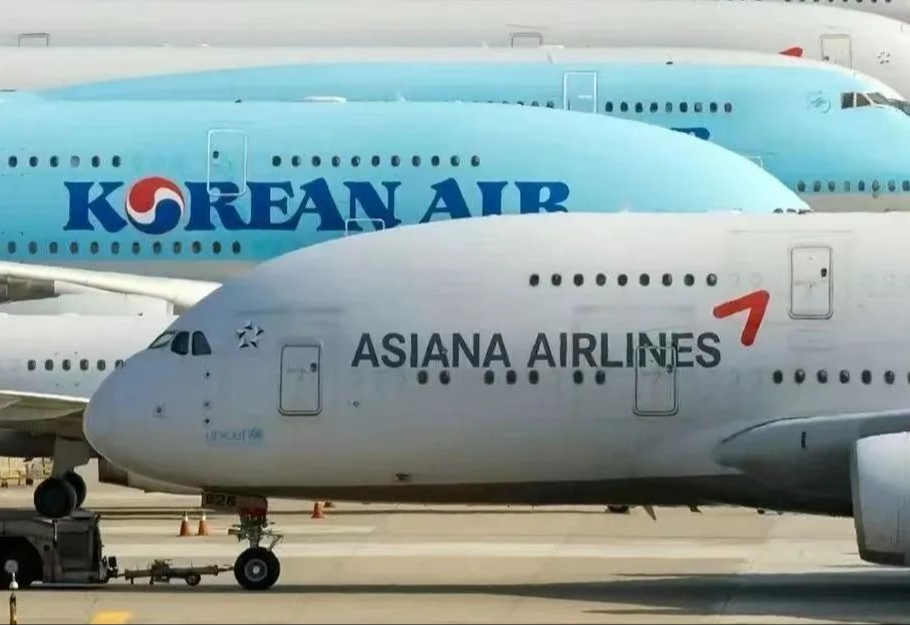Advertisements
The aviation landscape in South Korea is on the cusp of a significant transformation as it witnesses the long-awaited merger between two of its largest carriers: Korean Air and Asiana Airlines. After four years of navigating regulatory hurdles and obtaining necessary approvals, the merger has finally come to fruition, marking a pivotal point in the history of the nation’s airline sector.
On December 2, 2023, the U.S. Department of Justice granted approval for this landmark merger, closely following the European Commission's green light at the end of November. This momentous decision symbolizes the end of a competitive landscape characterized by two dominant airlines and various low-cost carriers, transitioning the market into a new era consisting of a singular powerhouse.
As part of the agreement, Korean Air has committed to acquiring approximately 132 million shares of Asiana Airlines, a transaction valued at 1.5 trillion won (around 77 billion yuan). By doing this, Korean Air will increase its stake in Asiana to about 63.9%, effectively consolidating both airlines and their subsidiaries into a formidable conglomerate.
This merger not only has significant implications for the Korean aviation market but is also poised to reshape the global tourism and transportation industries. With over 200 aircraft under its banner post-acquisition, the newly consolidated airline will rank among the top ten largest carriers worldwide. This new entity will be able to leverage economies of scale to optimize its operations, enhance resource allocation, and improve the efficiency of its flight routes, especially in the increasingly competitive markets of China and Japan.
Background and Context
The journey towards this merger began in the late 20th century, a period marked by the privatization of global aviation and a shift towards open skies policies. Established in 1988, Asiana Airlines quickly made its mark, achieving a milestone of three million passengers just 16 months after its inception. Yet, as the years progressed, both airlines faced varied challenges in a fluctuating industry landscape.
The turbulence for Asiana began around 2018. This period saw the airline grappling with a severe debt crisis, resulting in operational disruptions, including losing in-flight meal services for several consecutive days. By 2019, their financial reports received a "modified opinion" from external auditors, a clear signpost indicating underlying financial distress. Asiana's parent company, Kumho Group, struggled under the weight of excessive debt, which forced it to propose selling the airline and accepting the resignation of its chairman amid aggressive cost-cutting measures.
However, efforts to salvage Asiana, including a potential acquisition by Hyundai Development Group, fell through as the global pandemic sparked further woes. COVID-19 devastated the aviation sector, rendering many firms, including Asiana, vulnerable due to high fixed costs and dwindling passenger counts. At one point, the debt ratio for Asiana soared to a staggering 640%, compelling the necessity for a sale.

Recognizing the strategic importance of both airlines to the national economy, the South Korean government intervened, allowing state-owned Korea Development Bank to inject 800 billion won into Korean Air’s parent company to facilitate the merger and mitigate downturns associated with the pandemic.
The regulatory journey leading up to the merger was arduous. Antitrust considerations necessitated that the merger gain approval from regulators in multiple countries, including the U.S., China, and members of the European Union. The Korean Fair Trade Commission required that the airlines transfer certain slots and market access to preserve competition, while the U.S. Department of Justice demanded that Asiana’s cargo operations be divested as a condition of approval.
Eventually, after satisfying the various requirements from regulatory bodies across 14 nations, Korean Air's merger with Asiana was officially approved, paving the way for a streamlined operational structure. The next steps involve smoothly transitioning Asiana Airlines as a subsidiary, with a forecasted trial period for two years where aspects like corporate culture and loyalty programs will be integrated.
Future Outlook
The merger signals not just economic recovery but also ambitions to solidify South Korea's competitive stance in the broader Asian and global airline markets. Korean Air, in tandem with Asiana, is expected to fortify its market position, with plans to expand its fleet, having already added 83 new aircraft and aiming for capacity restoration in line with pre-pandemic levels.
Meanwhile, the integration of the two airlines reflects a trend of consolidation in the global airline industry, as firms seek greater resilience against future market shocks. It's a proactive move to respond to competitive pressures stemming from low-cost carriers as well as other full-service airlines. The future could also see additional collaborations among low-cost subsidiaries under each airline as they adapt to market needs.
In essence, this merger serves as a case study for how traditional aviation companies can innovate and respond to changing economic landscapes and competitive pressures. The merger of Korean Air and Asiana Airlines may ultimately revive not just these airlines but also represent a significant milestone for South Korea's tourism industry's competitiveness and infrastructure. It reflects resilience in an industry which, despite its challenges, remains integral to global connectivity and economic growth.
Leave a Comment